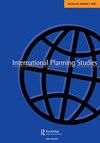Long-established rules and emergent challenges: spatial planning and wildfires in Chile
IF 1.5
Q4 REGIONAL & URBAN PLANNING
引用次数: 1
Abstract
ABSTRACT It is generally expected that spatial planning integrates wildfire risk reduction considerations in areas affected by this hazard. However, many spatial planning systems are challenged to adequately deal with this risk. There is a need for applied understandings of planning systems characteristics that facilitate or impede wildfire risk reduction. Accordingly, this research explores spatial planning limitations to the integration of wildfire risk reduction measures by comparing spatial planning and wildfire risk reduction measures based on five key dimensions: structure, realm, spatial scale, territorial boundaries, and time scale. The research used a qualitative case study strategy of the Chilean spatial planning system, employing qualitative content analysis of key documents. The results show that the long-established characteristics of Chile’s spatial planning limit its ability to accommodate wildfire risk reduction measures in the five dimensions analyzed. The research contributes to understanding some of spatial planning’s constraints to manage wider complex challenges.长期确立的规则和紧急挑战:智利的空间规划和野火
人们普遍认为,在受野火影响的地区,空间规划应考虑降低野火风险的因素。然而,许多空间规划系统面临着充分应对这一风险的挑战。有必要对促进或阻碍减少野火风险的规划系统特征进行应用理解。基于此,本研究从结构、领域、空间尺度、地域边界和时间尺度五个关键维度对空间规划与野火风险降低措施进行比较,探讨空间规划对野火风险降低措施整合的限制。本研究采用智利空间规划系统定性案例研究策略,对关键文献进行定性内容分析。结果表明,智利空间规划的长期特征限制了其在分析的五个维度中适应减少野火风险措施的能力。这项研究有助于理解空间规划的一些限制,以应对更广泛的复杂挑战。
本文章由计算机程序翻译,如有差异,请以英文原文为准。
求助全文
约1分钟内获得全文
求助全文
来源期刊

International Planning Studies
REGIONAL & URBAN PLANNING-
CiteScore
4.60
自引率
4.80%
发文量
20
期刊介绍:
Planning, at urban, regional, national and international levels, faces new challenges, notably those related to the growth of globalisation as both an objective socio-economic process and a shift in policy-maker perceptions and modes of analysis. International Planning Studies (IPS) addresses these issues by publishing quality research in a variety of specific fields and from a range of theoretical and normative perspectives, which helps improve understanding of the actual and potential role of planning and planners in this context.
 求助内容:
求助内容: 应助结果提醒方式:
应助结果提醒方式:


